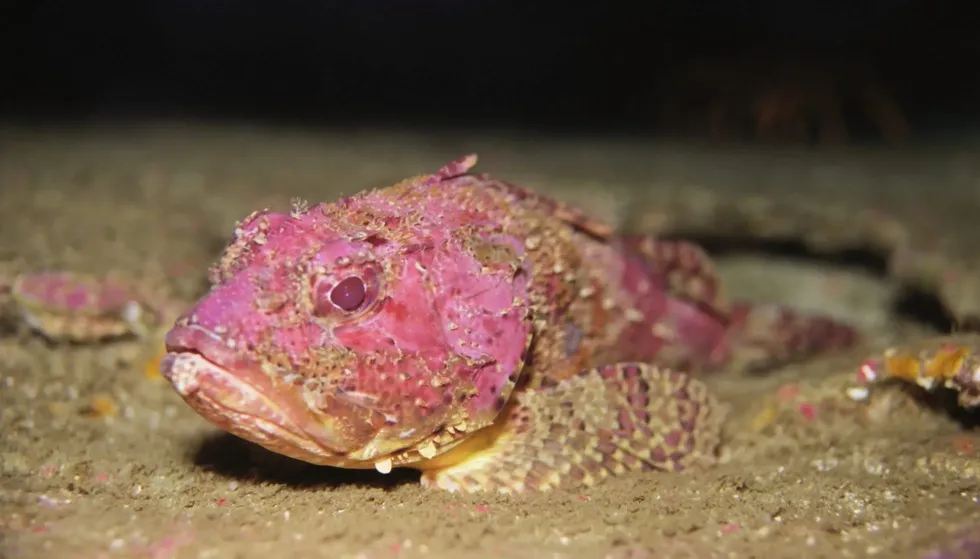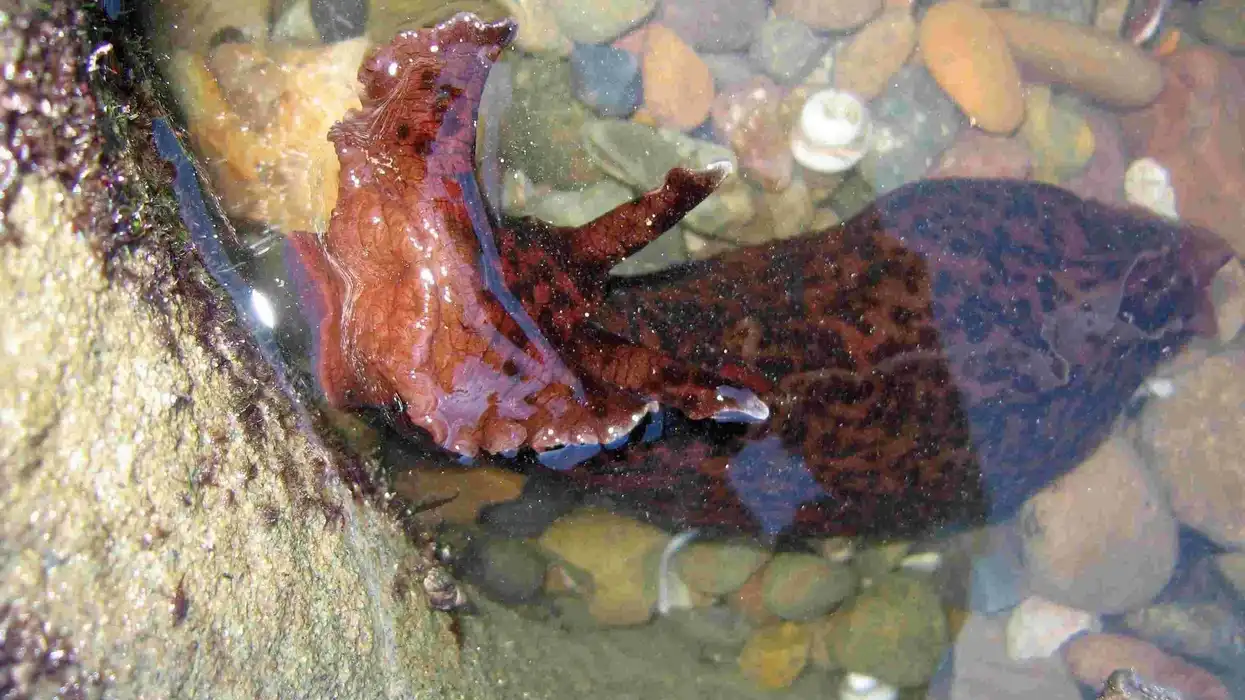California scorpionfish is a species of scorpionfish and is a member of the Scorpaenidae family that comprises the scorpionfish and rockfish species. It is commonly called sculpin by local anglers.
It is a bottom-dweller and can be seen inhabiting shallow water at the depth of 98.4 ft (30 m) on rocky reefs. It is indigenous to the eastern Pacific Ocean temperate waters. Its distribution ranges from Santa Cruz, California towards Baja California Sur.
A small population can also be seen in the Gulf of California (Sea of Cortez). It can be found living on the coasts of Southern California than the north of California.
It ranges between 6-19 in (15.2-48.2 cm) in length and 1-2 lb (0.4-0.9 kg) in weight. The coloration of this fish is majorly red and brown and has some white and lavender mixed in.
It is nocturnal when it comes to its feeding habits. It is carnivorous and its diet comprises octopuses, small crabs, shrimp, fish, squid, crustacean, prawns, eels, shrimp, yellow rock crab, and small fish. Keep reading to get to know more about facts about the habitat, distribution, physical description, and more of this spiny scorpionfish!
If you enjoyed reading our fun California scorpionfish facts, you must check out our beluga sturgeon surprising facts and Chinook salmon facts for kids!
California Scorpionfish Interesting Facts
What type of animal is a California scorpionfish?
California scorpionfish (Scorpaena guttata) is a species of scorpionfish. It is a marine bony fish that is a member of the Scorpaenidae that comprises the scorpionfish and rockfish species. It is indigenous to the eastern Pacific Ocean temperate waters and can be commonly seen in Baja California.
It is commonly known as sculpin by local anglers but is it is only remotely related to the true sculpin. It dwells in rocky bottoms. It has venomous fin spines that can cause excruciating pain.
What class of animal does a California scorpionfish belong to?
California scorpionfish (Scorpaena guttata) is a member of the Scorpaenidae that comprises the scorpionfish and rockfish species. It belongs to the class of Actinopterygii.
How many California scorpionfish are there in the world?
The population of this fish has not yet been evaluated.
Where does a California scorpionfish live?
This fish is indigenous to the eastern Pacific Ocean temperate waters. Its distribution ranges from Santa Cruz, California towards Baja California Sur. A small population can also be seen in the Gulf of California (Sea of Cortez). It can be found living in Southern California that north.
What is a California scorpionfish's habitat?
This fish is endemic to North America. It is a bottom-dwellers and can be seen inhabiting shallow water at the depth of 98.4 ft (30 m) on rocky reefs. It prefers rocky bottoms and can be found in caves also! It also likes to travel and can swim for 124.2-217.4 mi (200-350 km).
Who do California scorpionfish live with?
They live in solitary and only meet up for the purpose of reproduction.
How long does a California scorpionfish live?
California scorpionfish (Scorpaena guttata) can live up to 21 years!
How do they reproduce?
The California scorpionfish spawn from April to September and peak from June to July. They make spawning migrations at the end of spring and the start of the summer, with the adults moving to depths of 98-360 ft (30-109.7 m). They are oviparous and the eggs undergo fertilization externally.
Scorpionfish are known to lay 15,000 eggs approximately that are embedded in egg balloons (gelatinous walls). These egg masses rise to the surface of the water from the rock bottoms. They hatch after five days.
What is their conservation status?
These fish have not yet been listed by the IUCN's Red List due to data being insufficient.
California Scorpionfish Fun Facts
What do California scorpionfish look like?
California scorpionfish ranges between 6-19 in (15.2-48.2 cm) in length. It has a rectangular-shaped body that is quite slender. It has dark spotting all over its body and fins.
It also possesses smooth scales. The coloration of these fish is majorly red and brown and has some white and lavender mixed in. The adult of this species has big spots on its pectoral, dorsal, caudal, and anal fins, whereas juveniles possess none.
This spotting is its characteristic feature and helps in differentiating it from the Player, Peruvian, and Rainbow scorpionfish as they do not possess any. The large head of this scorpionfish possesses numerous spines. These fin spines are filled with deadly venom.

*Please note that the second image is of a small red scorpionfish and not of a California scorpionfish. If you have an image of the California scorpionfish, please let us know at hello@kidadl.com
How cute are they?
These fish are quite terrifying in appearance. Their fin spines look harmful and are harmful as well. They have dark spotting on their body and do not look cute.
How do they communicate?
They communicate with individuals of their own species through noises, motion, and vibration of their muscles against their swim bladder (the organ that aids in maintaining the buoyancy of the fish).
How big is a California scorpionfish?
California scorpionfish (Scorpaena guttata) range between 6-19 in (15.2-48.2 cm) in length. Their length is similar to that of the telescope fish!
How fast can a California scorpionfish swim?
Scorpionfish are known to not move for the majority of their time as they wait for their next victim. They wait patiently and attack instantly when they get the chance.
How much does a California scorpionfish weigh?
California scorpionfish (Scorpaena guttata) range between 1 - 2 lb (0.4-0.9 kg) in weight.
What are the male and female names of the species?
The male is referred to as male California scorpionfish and the female as female California Scorpionfish.
What would you call a baby California scorpionfish?
California scorpionfish (Scorpaena guttata) babies are referred to as larvae. After a while, they can be known as juveniles or young.
What do they eat?
These fish are nocturnal when it comes to their feeding habits. These fish are carnivores and ambush predators.
Their diet comprises octopuses, small crabs, shrimp, small fish, squid, crustacean, prawns, eels, shrimp, yellow rock crab, and small fish. They are mainly preyed upon by rays, sharks, large snappers, and the California two-spot octopus, whose young are consumed by this fish. The spines of this fish are damages its predators, except that of the California two-spot octopus.
This fish is also consumed by humans who catch them all year round. These fish are also fished out as by-catch in rockfish fisheries.
Are they dangerous?
Yes, California scorpionfish is dangerous and is the most venomous family member of Scorpaenidae. Its pelvic, dorsal, and anal fins have spines that have venom in them and can cause excruciating pain if stung with these fin spines. The venom of these fish is compared to that of the rattlesnake, which is why it is known as scorpionfish.
Would they make a good pet?
It isn't considered ideal to keep any scorpionfish as a pet due to their venomous spines. Their sting can prove to be fatal.
However, a few aquarists do pet these deadly fish in aquariums that comprise rocks, coral reefs, and hiding sites to provide a proper habitat. In captivity, they can be fed crustaceans, squid, and prawns.
Keeping these fish in a small tank can harm other residents of the tank as they can be harmful unintentionally due to their venomous dorsal spines.
Did you know...
This fish is called sculpin by many anglers when they go to catch them. It has been called sculpin for a long time and is now a tradition of anglers!
What is the unique feature of scorpionfish?
Scorpionfish are found in the deepest parts of the Indo-Pacific oceans, at depth of 2624.6 ft (800 m)! They live alone and only socialize for breeding. They can remain motionless for long durations and then attack instantly to capture the prey! The growth rate of male scorpionfish is lower than that of female scorpionfish!
Is scorpionfish edible?
Yes, scorpionfish is edible. The fishermen sell their catch to the public and fish processors for consumption. It has an interesting texture. It is a mild-flavored scorpionfish that tastes best when fried. It is rich in Vitamin D and B12.
Here at Kidadl, we have carefully created lots of interesting family-friendly animal facts for everyone to discover! For more relatable content, check out these salmon interesting facts and shark surprising facts pages!
You can even occupy yourself at home by coloring in one of our free printable California scorpionfish coloring pages!










